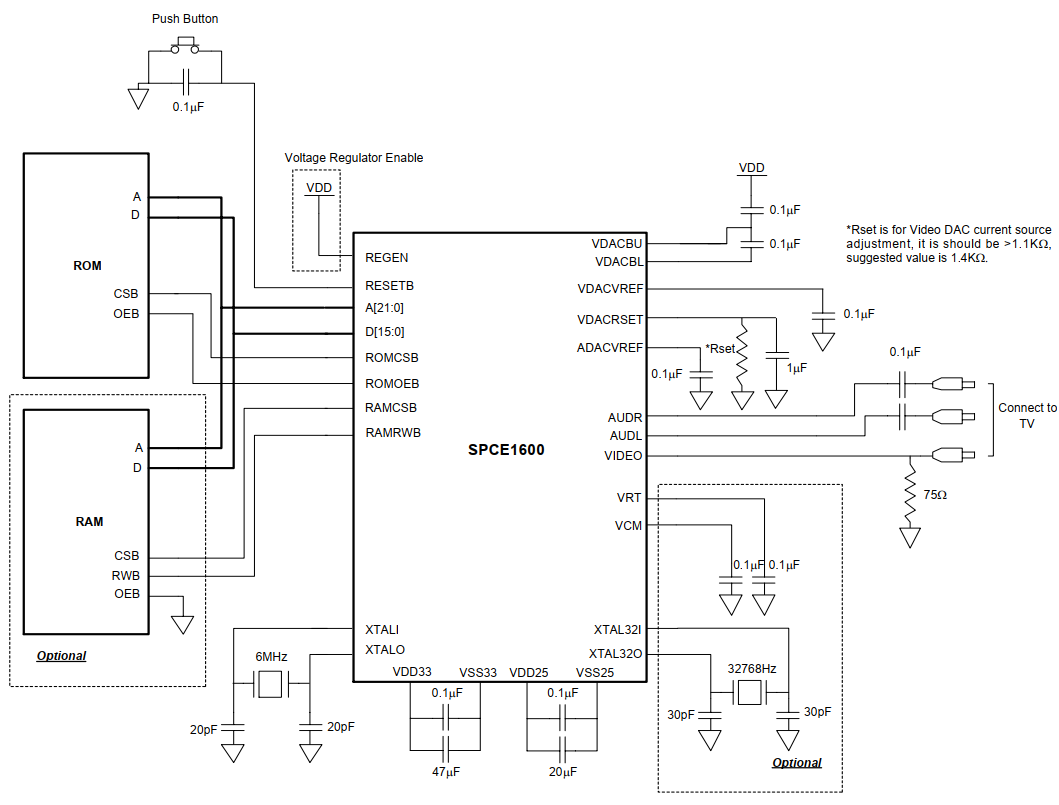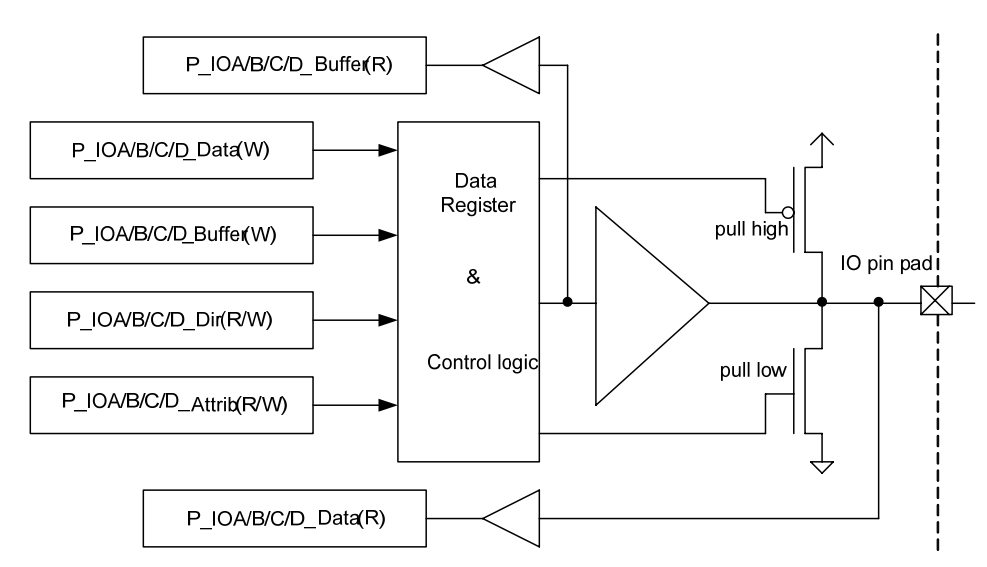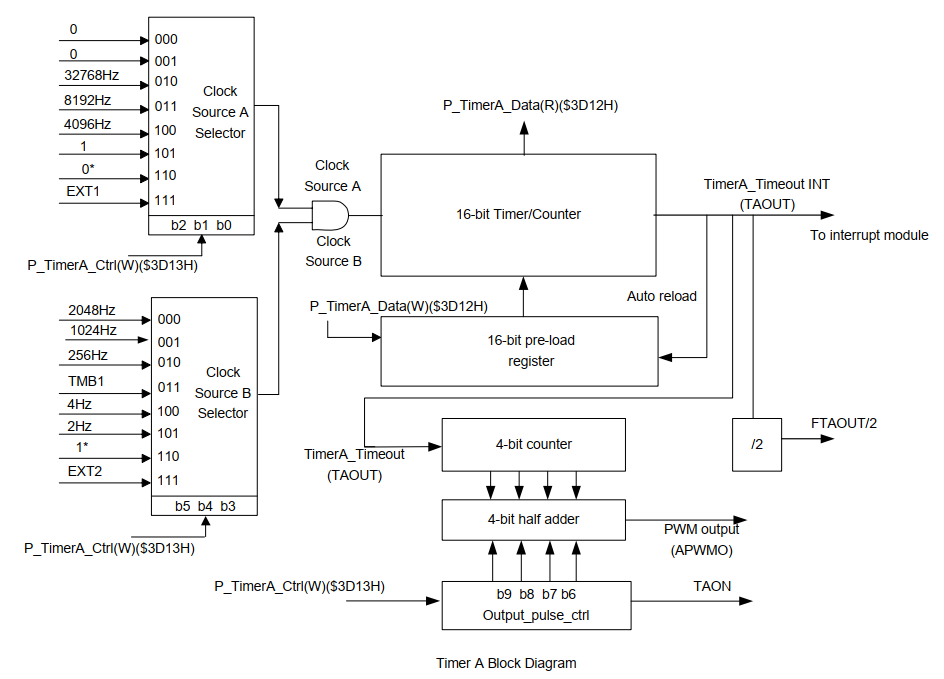Table of Contents

| Start | End | Description |
|---|---|---|
| 0x000000 | 0x0027FF | RAM |
| 0x002800 | 0x002FFF | PPU |
| 0x003000 | 0x0037FF | spu |
| 0x003D00 | 0x003DFF | IO |
| 0x003E00 | 0x003E03 | DMA |
External memory starts at 0x4000. It can be mapped to the internal ROM and the two possible chips in the cartridges.

IO registers

| Address | Contents |
|---|---|
| 3D00 | IO configuration |
| 3D01-3D05 | IOA registers |
| 3D06-3D0A | IOB registers |
| 3D0B-3D0F | IOC registers |
| 1/6/B | IOx data |
| 2/7/C | IOx buffer |
| 3/8/D | IOx direction |
| 4/9/E | IOx attributes |
| 5/A/F | IOx mask |
Each IO port is configured by 4 registers.
The direction register is 0 for input pins, 1 for output pins.
Global configuration register
- Bit 0: IOA special functions select
- Bit 1: IOB special functions select
These two bits allow to select one of two special functions for the IOA and IOB registers. Then each pin in that IO register can be switched between normal GPIO and special function using the MASK register.
For IOA, special = 0 selects the TFT display interface, special = 1 selects the STN LCD interface and I2S audio output.
For IOB, only special = 0 is documented and it selects the CSB0, CSB1, CSB2 chip select pins for external memory (further configured by port 3D23)
- Bit 2: IOA Wakeup enable
- Bit 3: IOB Wakeup enable
- Bit 4: IOC Wakeup enable
These bits enable system wakeup from sleep mode from activity on the corresponding IO ports. A typical setup on the V.Smile is to enable wakeup on port B to detect when the ON button is pressed.
Input pins configuration
If the attribute bit for a pin is 0, the data bit can be used to set a pull up or pull down resistor on the pin.
If the attribute bit is 1, the pin is floating without pull up or pull down.
It is possible to read both the internal buffer and the actual state of the pin.
Output pins configuration
If the attribute bit for a pin is 0, the output is inverted. Writing 1 to the data bit results in a logic 0 output. If the data bit is set to 0, the result is a logic 1 output.
If the attribute bit is 1, there is no inversion, and the data bit is output as is.
Timers

| Address | Contents |
|---|---|
| 3D10 | Timebase setup |
| 3D11 | Timebase clear |
| 3D12 | TimerA Data |
| 3D13 | TimerA Control: output_pulse_ctrl (bits 9-6), source B select bits (5-3), source A select bits (2-0) |
| 3D14 | TimerA enable (bit 0) |
| 3D15 | TimerA IRQ clear (bit 0) |
| 3D16 | TimerA DATA |
| 3D17 | TimerB Control: output_pulse_ctrl (bits 9-6), source C select bits (bits 2-0) |
| 3D18 | TimerB enable (bit0) |
| 3D19 | TimerB IRQ clear (bit0) |
| 3D1C | Scanline counter |
Timebase setup values:
- Bits 3-2: TMB2 frequency
- 00 - 128 Hz
- 01 - 256 Hz
- 10 - 512 Hz
- 11 - 1024 Hz
- Bits 1-0: TMB1 frequency
- 00 - 8 Hz
- 01 - 16 Hz
- 10 - 32 Hz
- 11 - 64 Hz
Timer A
Timer A ticks on the rising edge of the AND of sources A and B (so one source can be used to mask the other).
The counter is incremented at each tick until it reaches FFFF and overflows.
Reading the data register allows to know the current timer value.
When the timer overflows, several things happen:
- An interrupt is triggered (if activated)
- The FTAOUT pin is toggled
- The counter is reloaded to the last value written to the data register
- The 4 bit counter for PWM generation is incremented
Control register bits 2-0: Source A
- 00x: Timer disabled
- 010: 32768Hz
- 011: 8192Hz
- 100: 4096Hz
- 101: 1 (use source B only)
- 110: Timer disabled
- 111: EXT1
Control register bits 5-3: Source B
- 000: 2048Hz
- 001: 1024Hz
- 010: 256Hz
- 011: TMB1
- 100: 4Hz
- 101: 2Hz
- 110: 1 (use source A only)
- 111: EXT2
Control register bits 9-6: output pulse control

This configure the pulse width from 0 to 15 timer ticks. A new pulse starts every 16 ticks.
Misc. peripherals
| Address | Contents |
|---|---|
| 3D20 | System Control |
| 3D21 | Interrupts control |
| 3D22 | Interrupt status (read)/ clear (write) |
| 3D23 | External Memory Control |
| 3D24 | Watchdog clear (write 55AA) |
| 3D25 | ADC Control |
| 3D27 | ADC data |
| 3D28 | Sleep Mode (write AA55) |
| 3D29 | Wakeup Source |
| 3D2A | Wakeup Time |
| 3D2B | TV System (read only, bit0 indicaters NTSC or PAL) |
| 3D2C | Pseudo Random1 |
| 3D2D | Pseudo Random2 |
| 3D2E | FIQ Sel |
| 3D2F | DS register (sets or gets data segment value of CPU status register) |
System control
- Bit 15: enable watchdog
- Bit 14: enable sleep
- Bit 9: Low-voltage regulator output enable
- Bit 8: Low-voltage regulator enable
- Bit 7: #2V out
- Bits 6-5: Low-voltage regulator voltage select
- Bit 4: 32KHz clock
- Bit 2: Video DAC enable
- Bit 1: Audio DAC enable
Interrupts
The three interrupt registers have the same layout:
- Bit 13: ADC (interrupt vector is at FFFB)
- Bit 12: External interrupt 2 (FFFD)
- Bit 11: Timer A (FFFA)
- Bit 10: Timer B (FFFA)
- Bit 9: External interrupt 1 (FFFD)
- Bit 8: UART (FFFB)
- Bit 7: Key change (FFFF)
- Bit 6: 4096Hz (FFFE)
- Bit 5: 2048Hz (FFFE)
- Bit 4: 1024Hz (FFFE)
- Bit 3: 4Hz (FFFF)
- Bit 1: TMB1 (FFFF)
- Bit 0: TMB2 (FFFF)
There are interrupts coming from devices, which have separate enable bits in each of the devices.
The complete list of interrupt vectors is:
| Vector address | Name | Triggered by |
|---|---|---|
| FFF5 | BREAK | break CPU instruction |
| FFF6 | FIQ | configured by 3D2E |
| FFF7 | RESET | Console startup/reset |
| FFF8 | IRQ0 | PPU |
| FFF9 | IRQ1 | SPU |
| FFFA | IRQ2 | Timers A and B |
| FFFB | IRQ3 | UART, SPI, SIO, I2C |
| FFFC | IRQ4 | SPU beat and envelope |
| FFFD | IRQ5 | External interrupts |
| FFFE | IRQ6 | 1024, 2048 or 4096Hz ticker |
| FFFF | IRQ7 | 4Hz ticker, Timebase 1, Timebase 2, Low voltage detect, Key change |
As the vector addresses are only 16-bit, they can only point to the first segment (0x0000 - 0xFFFF).
External bus configuration
- Bits 11-8: External RAM decode control
- 0xxx - No mapping
- 1000 - Map
0x3ff000 - 0x3fffffto RAMCSB (4 kibiwords) - 1001 - Map
0x3fe000 - 0x3fffffto RAMCSB (8 kibiwords) - 1010 - Map
0x3fc000 - 0x3fffffto RAMCSB (16 kibiwords) - 1011 - Map
0x3f8000 - 0x3fffffto RAMCSB (32 kibiwords) - 1100 - Map
0x3f0000 - 0x3fffffto RAMCSB (64 kibiwords) - 1101 - Map
0x3e0000 - 0x3fffffto RAMCSB (128 kibiwords) - 1110 - Map
0x3c0000 - 0x3fffffto RAMCSB (256 kibiwords) - 1111 - Map
0x380000 - 0x3fffffto RAMCSB (512 kibiwords)
- Bits 7-6: ROM address decode control
- 00 - Map entire range to ROMCSB
- 01 - Map
0x4000 - 0x1fffffto ROMCSB,0x200000 - 0x3fffffto CSB1 - 1x - Map
0x4000 - 0x0fffffto ROMCSB,0x100000 - 0x1fffffto CSB1,0x200000 - 0x2fffffto CSB2,0x300000 - 0x3fffffto CSB3
- Bits 5-3: Bus arbitration priority control
- 101 - 1. Audio, 2. PPU, 3. CPU
- 111 - 1. PPU, 2. Audio, 3. CPU
- Bits 2-1: Number of wait states
- Bit 0: CKOEN
External RAM mapping overrides any ROM mapping.
On the V.Smile, both ROMCSB and CSB1 allow to access the cartridge ROM. This means bit 6 is not very useful.
CSB2 is the cartridge RAM, and CSB3 is the system ROM. They are both enabled at the same time by using bit 7.
ADC
Control register:
- Bit 13: interrupt status
- Bit 12: request conversion
- Bit 10: auto request
- Bit 9: interrupt enable
- Bit 8: VRT enable
- Bits 5-4: select channel
- Bits 3-2: clock select
- Bit 1: CSB
- Bit 0: ADE
Sleep/Wakeup
Wakeup source:
- Wakeup source: same layout as the interrupt registers, but only the 8 low bits are available?
- Wakeup time: number of 32kHz clock cycles (8 bits)
- Sleep: write AA55 here to start sleeping. CPU will be halted until the next wakeup event.
Pseudo random generators
There are two generators using the formula f(x) = x^15+x^14+1.
The first one has a default seed = 001_0100_0001_1000 The second one has a default seed = 001_0110_0101_1000
You can write the registers to set a new seed.
FIQ
There can only be a single FIQ source active at a time. This register selects which one.
- 000: PPU
- 001: SPU
- 010: TimerA
- 011: TimerB
- 100: UART(SPI)
- 101: External
- 110: ADC
- 111: None
DS register
This allows direct read and write access to the DS (Data Segment) register. Normally in the uN'SP architecture, this register is part of the CPU SR register. However, this makes it unconvenient to change its value. This memory mapped version of the register can be used with usual CPU instructions to set and use the DS value more conveniently.
UART

All UART registers are 8bit only.
| Address | Contents |
|---|---|
| 3D30 | UART Control (7: TxEn, 6: RxEn, 5: Mode, 4: MulPro, 3-2: bits per byte, 1: Tx Interrupt Enable, 0: Rx Interrupt Enable |
| 3D31 | UART Status (7: Rx buffer full, 6: Tx busy, 5: bit9, 4: overrun, 3: frame error, 2: parity, 1: tx ready, 0: rx ready |
| 3D32 | UART Reset (bit 0) |
| 3D33 | UART Baudrate setting (low byte) |
| 3D34 | UART Baudrate setting (high byte) |
| 3D35 | UART Tx buffer |
| 3D36 | UART Rx buffer |
Baudrate settings:
- 1200: FA 92
- 2400: FD 41
- 4800: FE A0
- 9600: FF 50
- 19200: FF A8
- 57600: FF E2
- 115200: FF F1
Before using the UART, the corresponding PINs need to be configured properly. IOC13 and IOC14 must be set to “special”/“mask” mode to disable the GPIO and assign the pin to UART. The example below also forces CTS A (IOC8) low, allowing the first controller port to transmit data. Normally this would only be done after receiving an RTS from said controller.
// Enable controller CTS *PORTC_DIR = 0x89c0; *PORTC_ATTR = 0x89c0; *PORTC_DATA = 0xf77f; // Enable Uart RX (controller input) *UART_BAUDRATE_LOW = 0xA0; *UART_BAUDRATE_HIGH = 0xFE; *UART_CONTROL = 0xc3; *UART_STATUS = 3; *PORTC_SPECIAL |= 0x6000; // UART Tx and Rx in "special" mode *PORTC_ATTR |= 0x6000; *PORTC_DIR |= 0x4000;
Reading from the UART then is quite simple:
- Wait until the status register indicates Rx ready (bit 0)
- When Rx is ready, read the Rx data register to get the byte
For transmitting, you need to check if the FIFO is cleared (bit 1 of status register) then you can push your bytes to the transmit register.
SPI
| Address | Contents |
|---|---|
| 3D40 | SPI Control (bit 8: busy, bit 7: tx empty, bit 6: rx full, bit 5: SPH, bit 4: SPO, bit 3: SPIEN, bit 2: LPM, bit 1: Tx Interrupt Enable, bit 0: Rx Interrupt Enable) |
| 3D41 | SPI Data (write to send, read to receive) |
| 3D42 |
General DMA
| Address | Contents |
|---|---|
| 3E00 | DMA Source address |
| 3E01 | DMA Source segment |
| 3E02 | DMA word count |
| 3E03 | DMA Target Address (14 bits) |
This is a DMA for generic purposes. Note that there is another DMA channel in the PPU registers.
Both DMA units operate in the same way. First, set the source and destination addresses. The source can be anywhere in memory, but the destination register is only 14 bits wide, which allows to target only the internal RAM and IO registers (you wouldn't write to ROM, would you?).
The transfer is started when you write the word count register, and you can read that register to know when the transfer is done (the register is 0 when there are no more words to transfer).
